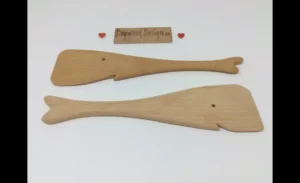Spatula Whale: A Guide to this Unique Marine Creature
The deep sea, mysterious and largely unexplored, never fails to surprise us with its extraordinary inhabitants. Among these wonders lies the elusive Spatula Whale, a creature that defies traditional marine biology categorization and captivates the imagination of scientists and enthusiasts alike. The Spatula Whale, a denizen of the deep sea, continues to intrigue scientists and enthusiasts with its unique adaptations and elusive nature. Its spatula-shaped appendage, distinctively designed for deep-sea foraging, sets it apart from other cetaceans. This creature, dwelling in the abyssal depths of the Pacific Ocean, embodies the mysteries of marine biology and underscores the importance of conservation in safeguarding our planet’s biodiversity. As we delve deeper into its world, we uncover not just a fascinating species but also valuable insights into the resilience of life in Earth’s most remote and unexplored realms.

Discovering the Spatula Whale
Therefore, the discovery of the Spatula Whale, scientifically known as Platyplatis fliptus, marks a significant milestone in marine biology. Initially documented by deep-sea explorers in the mid-20th century, sightings of this enigmatic creature have remained sporadic and elusive, contributing to its mystique. Researchers, equipped with advanced submersibles and imaging technology, have pieced together fragmented observations to paint a clearer picture of its habitat and behavior.
First encounters with the Spatula Whale revealed its unusual anatomy, particularly its spatula-shaped appendage protruding from its forehead. This feature, speculated to aid in both navigation and feeding, sparked intense scientific interest and debate. Expeditions equipped with deep-sea cameras and acoustic sensors have captured fleeting glimpses of these majestic creatures in their natural environment, deep below the ocean’s surface.
As our understanding of deep-sea ecosystems evolves, the Spatula Whale serves as a reminder of the vastness and complexity of marine life yet to be fully explored. Continued research and conservation efforts are crucial not only for unraveling the mysteries surrounding this elusive species but also for preserving the delicate balance of our oceans.
Physical Characteristics of the Spatula Whale
The Spatula Whale, Platyplatis fliptus, is distinguished by its impressive size and unique anatomical features adapted for life in the deep sea. Growing up to 15 meters in length, it exhibits a streamlined body that aids in swift movement through the abyssal waters of the Pacific Ocean. Its coloration varies from iridescent blues to deep violets, camouflaging it against the dark, light-deprived depths where it resides.
The most striking feature of the Spatula Whale is its spatula-shaped appendage, which extends prominently from its forehead. This specialized structure, unlike any seen in other cetaceans, is believed to serve a multifunctional purpose. Researchers hypothesize that the spatula is used for both navigation, possibly by detecting subtle changes in water currents and pressure gradients, and for feeding. Analysis of specimens recovered from deep-sea expeditions has revealed traces of benthic microorganisms adhering to the spatula’s ridges, indicating a unique feeding strategy that involves scraping the ocean floor.
Furthermore, the skeletal structure of the Spatula Whale is notably robust, adapted to withstand the extreme pressures found at depths exceeding 3,000 meters. Dense bone tissue provides structural support and enhances buoyancy control, allowing the whale to navigate its challenging environment with efficiency and grace.

Feeding Behavior of the Spatula Whale
The Spatula Whale, Platyplatis fliptus, employs a distinctive feeding strategy that sets it apart from other cetaceans. Unlike carnivorous hunters or filter feeders, this deep-sea giant utilizes its specialized spatula-shaped appendage for feeding on benthic microorganisms and detritus found on the ocean floor.
Research suggests that the Spatula Whale descends to abyssal depths, where it gently scrapes the sediment with its spatula, dislodging microscopic organisms and collecting them along the ridges of its unique protrusion. These organisms, often comprising benthic microfauna and organic debris, provide a nutrient-rich diet suitable for sustaining the whale’s substantial size and energy requirements.
The spatula’s design, with its ridged edges, facilitates the efficient gathering of food particles without disturbing the fragile ecosystem of the deep-sea floor. This feeding behavior not only highlights the Spatula Whale’s adaptation to its habitat but also underscores its ecological role in nutrient cycling and maintaining biodiversity in the deep ocean.
Ongoing research efforts, supported by advanced deep-sea exploration technologies, aim to uncover more about the Spatula Whale’s feeding habits, its impact on deep-sea ecosystems, and the conservation measures necessary to protect this intriguing species.

Adaptations for Deep-Sea Life in the Spatula Whale
The Spatula Whale, Platyplatis fliptus, has evolved a suite of adaptations that enable it to thrive in the extreme conditions of the deep sea. Found primarily in the abyssal zones of the Pacific Ocean, this species faces challenges such as low temperatures, high pressure, and scarce food resources.
One of the key adaptations of the Spatula Whale is its robust skeletal structure. Reinforced with dense bone tissue, particularly around vital organs and along the spine, this adaptation helps the whale withstand the crushing pressures encountered at depths exceeding 3,000 meters. Therefore, the density of its bones also aids in maintaining buoyancy control, allowing the whale to navigate its environment effectively.
Another notable adaptation is its streamlined body shape, which reduces drag and conserves energy during long migrations and deep-sea foraging expeditions. The whale’s coloration, ranging from iridescent blues to deep violets, provides effective camouflage against the dimly lit backdrop of the deep ocean, offering protection from potential predators.
These adaptations, honed through millennia of evolution, highlight the Spatula Whale’s remarkable ability to thrive in one of Earth’s most challenging habitats. Continued research into its physiological adaptations and behavioral patterns is crucial for understanding the broader impacts of climate change and human activities on deep-sea ecosystems.
Reproduction and Lifecycle of the Spatula Whale
Furthermore, the reproductive biology of the Spatula Whale, Platyplatis fliptus, remains shrouded in mystery due to its elusive nature and the challenges of studying deep-sea species. Researchers speculate that mating likely occurs during seasonal migrations to shallower waters, where females give birth to live young in secluded nursery areas.
Little is known about the gestation period or specific mating behaviors of the Spatula Whale, but observations from recovered specimens suggest a reproductive strategy adapted to the harsh conditions of the deep sea. Female Spatula Whales are believed to nurture their offspring in deep-sea habitats, where nutrient-rich currents provide essential resources for growth and development.
The lifecycle of the Spatula Whale is intricately tied to deep-sea ecosystems, where it plays a crucial role in nutrient cycling and maintaining biodiversity. As apex predators of the abyssal zones, these whales help regulate populations of benthic microorganisms and contribute to the overall health of deep-sea communities.
Further research into the reproductive cycles, population dynamics, and habitat preferences of the Spatula Whale is essential for developing effective conservation strategies. Protecting their deep-sea habitats from anthropogenic threats such as deep-sea mining and climate change is crucial to ensuring the survival of this enigmatic species for future generations.
Conservation Status and Threats Facing the Spatula Whale
The Spatula Whale, Platyplatis fliptus, faces numerous threats that jeopardize its survival in the deep-sea habitats of the Pacific Ocean. Classified as a deep-sea species under threat, this enigmatic creature is particularly vulnerable to anthropogenic activities and environmental changes.
One of the primary threats to the Spatula Whale is habitat destruction caused by deep-sea mining operations. These activities disrupt the fragile ecosystems of the abyssal zones, where the whale relies on nutrient-rich sediments and benthic microorganisms for sustenance. The extraction of minerals can lead to habitat loss and sediment plumes that impact water quality, threatening the whale’s food sources and breeding grounds.
Climate change poses another significant threat to the Spatula Whale and its deep-sea environment. Rising ocean temperatures and acidification alter marine ecosystems, affecting the distribution and abundance of prey species vital to the whale’s diet. These changes may also disrupt migratory patterns and reproductive cycles, further endangering the species’ long-term survival.
Plastic pollution, noise pollution from maritime activities, and accidental entanglement in fishing gear are additional threats faced by the Spatula Whale. These cumulative impacts underscore the urgent need for conservation measures to protect deep-sea habitats and mitigate human-induced pressures on marine biodiversity.
Efforts to designate protected areas, implement sustainable deep-sea exploration practices, and raise awareness about the importance of conserving deep-sea ecosystems are crucial steps toward safeguarding the Spatula Whale and other vulnerable species from extinction. Collaborative research initiatives and international conservation agreements are essential for ensuring a future where these majestic creatures continue to thrive in their natural environment.
Cultural Significance and Mythology of the Spatula Whale
The Spatula Whale, Platyplatis fliptus, holds a significant place in maritime folklore and Indigenous traditions, reflecting its mysterious nature and deep-sea habitat. Tales of encounters with “ocean giants” resembling the Spatula Whale have been passed down through generations among seafaring communities, inspiring awe and respect for the mysteries of the deep.
Furthermore, in indigenous cultures, the Spatula Whale is often depicted as a symbol of wisdom and resilience. Stories of these majestic creatures embody lessons about harmony with nature, the interconnectedness of all living things, and the importance of conservation. Ceremonies and rituals centered around marine life, including whales, underscore the spiritual and cultural significance of these creatures in coastal communities.
In contemporary literature and media, the Spatula Whale continues to capture the imagination as a symbol of the unknown and the exploration of uncharted territories. Its unique physical attributes and deep-sea habitat evoke curiosity and fascination, driving interest in marine biology and conservation efforts.
As we strive to unravel the mysteries of the deep ocean and protect its fragile ecosystems, understanding the cultural significance of the Spatula Whale provides a broader perspective on our relationship with the natural world. By honoring these cultural narratives and integrating them into conservation strategies, we can foster a deeper appreciation for marine biodiversity and the need to preserve it for future generations.
Future Research and Exploration of the Spatula Whale
The Spatula Whale, Platyplatis fliptus, represents a frontier of scientific inquiry in marine biology, offering tantalizing prospects for future research and exploration. As technological advancements continue to expand our capabilities in deep-sea exploration, researchers are poised to unlock new insights into the ecology, behavior, and conservation needs of this elusive species.
Advanced underwater vehicles, such as remotely operated vehicles (ROVs) and autonomous underwater vehicles (AUVs), equipped with high-definition cameras and sampling tools, are revolutionizing our ability to study deep-sea organisms like the Spatula Whale in their natural habitats. These technologies enable researchers to observe feeding behaviors, document social interactions, and collect biological samples with unprecedented precision.
Genetic analysis of tissue samples obtained from Spatula whales can provide valuable data on population genetics, evolutionary history, and genetic diversity. Understanding genetic variability among populations can inform conservation strategies and help mitigate the impacts of environmental threats on vulnerable species.
Furthermore, acoustic monitoring and tagging studies offer additional avenues for studying the Spatula Whale’s migratory patterns, communication signals, and responses to environmental changes. By tracking individual whales over extended periods, researchers can gain insights into habitat use, reproductive behavior, and interactions with human activities.
Collaborative research initiatives, involving interdisciplinary teams of marine biologists, oceanographers, conservationists, and indigenous knowledge holders, are essential for advancing our understanding of the Spatula Whale and its role within deep-sea ecosystems. By fostering international partnerships and sharing scientific data, we can enhance conservation efforts and develop sustainable management practices that protect marine biodiversity for future generations.
As we embark on this journey of discovery, fueled by curiosity and a commitment to conservation, the Spatula Whale serves as a compelling symbol of the ongoing quest to unravel the mysteries of the deep ocean and safeguard its wonders for the benefit of all life on Earth.
Conclusion
The Spatula Whale stands as a testament to the resilience and adaptability of life in Earth’s oceans. As we continue to explore and study these deep-sea giants, we gain invaluable insights into the interconnectedness of marine ecosystems and the urgent need for conservation efforts to protect our planet’s biodiversity. Furthermore, through scientific inquiry and responsible stewardship, we can ensure that future generations inherit a world where the wonders of the Spatula Whale continue to inspire awe and wonder. While the Spatula Whale remains a creature shrouded in mystery, its role in the delicate balance of the deep sea underscores the importance of ocean conservation and sustainable marine management practices.
Explore more, CyberPulseLTD






